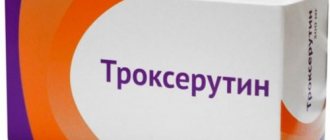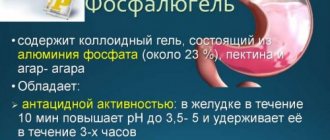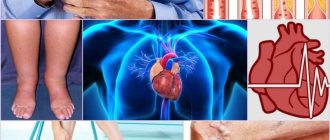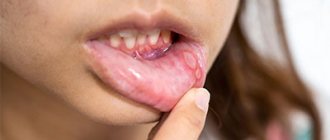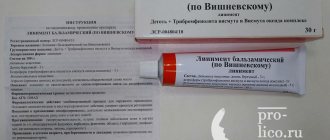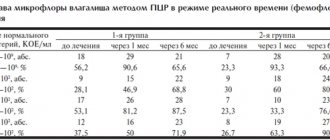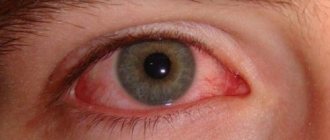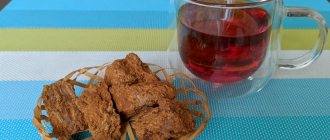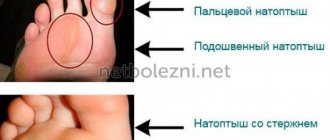Pharmacology
The medicine helps relax the smooth muscles of internal organs. After taking it, there is an improvement in the tone of the walls of blood vessels, they become less distensible, as a result of which blood stagnation disappears, the likelihood of edema decreases, and the severity of inflammatory processes decreases.
Capsules for oral administration are easily excreted from the stomach. The maximum concentration of the active element occurs 3-7 hours after administration. The second peak occurs approximately 28 hours later. The drug leaves the body completely within a day. Most of it is excreted by the liver, and a small part is excreted by the kidneys.
When the gel is applied locally, the constituent elements do not leak into the blood, but they still penetrate into the tissue adjacent to the skin.
In what cases is it used
Taking the drug is advisable in the following cases:
- varicose veins (including when carrying a child);
- chronic venous insufficiency;
- haemorrhoids;
- tissue swelling;
- influenza, measles, scarlet fever;
- vascular effects resulting from radiation exposure;
- high permeability of capillary walls.
After surgery on the veins, it can be taken for preventive purposes.
Troxerutin gel for external use 2% tube 40 g (Tula Pharmaceutical Factory)
Registration Certificate Holder
TULA PHARMACEUTICAL FACTORY (Russia)
Dosage form
Medicine - Troxerutin
Description
Gel for external use
from yellow to light brown or yellow-green, uniform, transparent.
100 g
troxerutin 2 g
Excipients
: carbomer 940 0.6 g, disodium edetate 0.05 g, benzalkonium chloride 0.0575 g, sodium hydroxide 30% - 0.7 g, purified water - up to 100 g.
20 g - orange glass jars (1) - cardboard packs. 25 g - orange glass jars (1) - cardboard packs. 30 g - orange glass jars (1) - cardboard packs. 40 g - orange glass jars (1) - cardboard packs. 50 g - orange glass jars (1) - cardboard packs. 60 g - orange glass jars (1) - cardboard packs. 70 g - orange glass jars (1) - cardboard packs. 80 g - orange glass jars (1) - cardboard packs. 100 g - orange glass jars (1) - cardboard packs. 20 g - polymer jars (1) - cardboard packs. 25 g - polymer jars (1) - cardboard packs. 30 g - polymer jars (1) - cardboard packs. 40 g - polymer jars (1) - cardboard packs. 50 g - polymer jars (1) - cardboard packs. 60 g - polymer jars (1) - cardboard packs. 70 g - polymer jars (1) - cardboard packs. 80 g - polymer jars (1) - cardboard packs. 100 g - polymer jars (1) - cardboard packs. 20 g - aluminum tubes (1) - cardboard packs. 25 g - aluminum tubes (1) - cardboard packs. 30 g - aluminum tubes (1) - cardboard packs. 40 g - aluminum tubes (1) - cardboard packs. 50 g - aluminum tubes (1) - cardboard packs. 60 g - aluminum tubes (1) - cardboard packs. 70 g - aluminum tubes (1) - cardboard packs. 80 g - aluminum tubes (1) - cardboard packs. 100 g - aluminum tubes (1) - cardboard packs.
Indications
Varicose veins, chronic venous insufficiency, accompanied by swelling, pain, a feeling of heaviness in the legs, thrombophlebitis, periphlebitis, varicose dermatitis, pain and swelling after injuries (bruises, ligament damage).
Contraindications for use
Hypersensitivity to troxerutin;
violation of the integrity of the skin in the area of application. With caution
In patients with chronic renal failure (with long-term use).
pharmachologic effect
A drug for the treatment of chronic venous insufficiency, a semi-synthetic bioflavonoid (rutin derivative) of the benzopyran class, has P-vitamin activity, has a venotonic, angioprotective, anti-inflammatory and decongestant effect, reduces capillary permeability and fragility.
Its pharmacodynamic properties are associated with the participation of the bioflavonoids troxerutin in redox processes and inhibition of hyaluronidase. By inhibiting hyaluronidase, troxerutin stabilizes the hyaluronic acid of cell membranes and reduces their permeability. It has antioxidant activity, which prevents the oxidation of ascorbic acid, adrenaline and lipids. In addition, it reduces the permeability and fragility of capillaries, prevents damage to the basement membrane of endothelial cells when exposed to various factors. Troxerutin increases the density of the vascular wall, reduces the exudation of the liquid part of the plasma and the diapedesis of blood cells. Reduces exudative inflammation in the vascular wall, reducing platelet adhesion to its surface.
Reduces swelling and a feeling of heaviness in the legs, reduces the intensity of pain and cramps, improves tissue trophism.
Drug interactions
When used simultaneously, it enhances the effect of ascorbic acid on the resistance and permeability of the vascular wall.
Dosage regimen
Apply externally 3-4 times a day for no more than 10 days.
Side effect
For external use:
rarely - allergic reactions (urticaria, eczema, dermatitis).
special instructions
Avoid contact of the drug containing troxerutin with open wounds, eyes and mucous membranes.
Use during pregnancy and breastfeeding
Restrictions during pregnancy - With caution. Restrictions when breastfeeding - Contraindicated.
Use in the first trimester of pregnancy is contraindicated. The possibility of use in the second and third trimesters of pregnancy is determined by the doctor and is possible only if the expected benefit to the mother outweighs the potential risk to the fetus.
There are no data on the penetration of troxerutin into breast milk. Use during breastfeeding is contraindicated.
Use for renal impairment
Restrictions for impaired renal function - With caution.
In patients with chronic renal failure (with long-term use).
Use in elderly patients
Restrictions for elderly patients - No restrictions. The drug is approved for use in elderly patients.
Use in children
Restrictions for children - Contraindicated. The drug is contraindicated for use in children and adolescents under the age of 18 years.
How to take capsules correctly
The tablets must be taken with food. The capsule cannot be chewed or dissolved; it must be swallowed whole with water. The permissible dose is 1 tablet three times a day. If the drug is taken as an auxiliary medicine, then you need to take 2 tablets per day. The duration of the therapeutic course is 20-28 days. Only a doctor can extend the course of treatment.
Depending on the manufacturer of the drug, there may be minor differences in the instructions for use. Taking Troxerutin Zentiva capsules is similar to the regimen described above, while Troxerutin Vramed in the first days of therapy should be taken 1 capsule no more than 3 times a day, after which switch to maintenance therapy, taking 1 tablet per day.
Troxerutin-MIC involves administering the drug intramuscularly or intravenously. One injection will require 0.5 active substance. The procedure should be carried out every other day. The course must include at least 5 injections. After the injections, you can begin treatment with tablets.
How to take Troxerutin gel
The drug in the form of a gel is intended for local application. It should be applied to the problem area 2 times a day (morning and evening). The ointment should be distributed in a thin layer over the entire damaged area, without affecting healthy skin. You need to rub the product in with smooth massaging movements until the gel is completely absorbed.
The permissible dose depends on the size of the problem skin, but should not be more than 2 g. When the ointment is applied, a bandage should be applied to the surface of the skin.
The drug in the form of an ointment, regardless of the manufacturer, has a similar treatment regimen.
Troxerutin A-LAB toning gel-cream 2% 50ml
A country
Russia
The country of production may vary depending on the batch of goods. Please check with the operator for detailed information when confirming your order.
Compound
Water, propylene glycol, troxerutin, dicapryl ether, polysorbate 20, menthol, horse chestnut extract, lemon essential oil, carbomer, phenoxyethanol, ethylhexylglycerin, Trilon B, sodium hydroxide.
Description
Foot gel-cream is designed for effective foot skin care. Due to the content of a complex of active components, the gel helps relieve fatigue and heaviness in the legs. Troxerutin in combination with horse chestnut has a tonic and decongestant effect. The menthol included in the composition has a cooling effect and creates the effect of “light legs”. Lemon essential oil provides a deodorizing effect. The effective formula of the gel-cream for feet gives a feeling of lightness and returns a feeling of comfort to the feet.
Pharmacological properties
THE GEL CREAM INCLUDES ACTIVE COMPONENTS:
Troxerutin - a flavonoid, a derivative of rutin (vitamin P) - has a venotonic, angioprotective, decongestant and antioxidant effect.
Horse chestnut extract - contains bioflavonoids, rutin, carotenoids, vitamins B, K, P, polysaccharides. Contains esculin, which determines the main biological activity of the extract: the ability to strengthen the walls of blood vessels and capillaries, stimulate blood circulation, and improve metabolic processes in skin cells.
Menthol - provides a cooling effect. It has weak local anesthetic properties, stimulates cold receptors of the skin and mucous membranes, is a weak antiseptic, and gives a slight antibacterial effect.
Lemon essential oil helps increase energy metabolism in the skin and stimulates collagen synthesis. Cleanses, refreshes, improves skin condition. It has an antibacterial effect, stimulates the regeneration process of skin cells, smoothes out fine wrinkles.
Indications for use
Foot gel-cream is designed for effective foot skin care. Due to the content of a complex of active components, the gel helps relieve fatigue and heaviness in the legs. Troxerutin in combination with horse chestnut has a tonic and decongestant effect. The menthol included in the composition has a cooling effect and creates the effect of “light legs”. Lemon essential oil provides a deodorizing effect. The effective formula of the gel-cream for feet gives a feeling of lightness and returns a feeling of comfort to the feet.
Contraindications
Individual intolerance to components.
Directions for use and doses
Apply a small amount of gel cream evenly in a thin layer to the problem area 2 times a day and rub in with massage movements until completely absorbed. Before each application, clean the skin with warm water or a warm, damp cloth. Avoid contact with eyes and mucous membranes.
Storage conditions
Store at temperatures from +5 °C to +25 °C in a dry place, protected from light and away from heating devices. Keep out of the reach of children
Best before date
2 years
Vacation conditions
Over the counter
Contraindications
Contraindications include:
- hypersensitivity to the constituent substances of the drug;
- chronic gastritis in the acute stage;
- stomach ulcer;
- children under 15 years of age;
- lactation period;
- 1st trimester of pregnancy.
Use with caution in case of kidney problems (if long-term treatment is necessary).
special instructions
The drug in one of its forms can be used as part of a complex treatment. In case of vein thrombosis, parallel use of appropriate medications is allowed.
Shelf life: capsules – 5 years, gel – 2 years from the date of production.
Store in a dark place. Storage temperature for gel is 10-15 degrees, for capsules - 17-25 degrees.
Sold in any pharmacy without a doctor's prescription.
Manufacturers assure that the drug is absolutely harmless. It is prescribed to people who are overweight, as well as to the fair sex who wear high-heeled shoes. The medicine is recommended for people whose work requires constant standing.
To achieve maximum effect, you need to use gel and capsules from the same manufacturer. In the absence of contraindications, it is best to use Troxerutin together with ascorbic acid for a more pronounced effect.
Troxerutin
Dosage form: gel for external use.
Composition per 100 g:
active ingredient: troxerutin (in terms of 100% substance) – 2.00 g;
excipients: carbomer 940 - 0.6 g, disodium edetate - 0.050 g, benzalkonium chloride - 0.0575 g, sodium hydroxide 30% - 0.700 g, purified water - up to 100 g.
Description: homogeneous transparent gel from yellow to light brown or yellow-green.
Pharmacotherapeutic group: venotonic and venoprotective agent.
ATX code: C05CA04.
pharmachologic effect
Pharmacodynamics. Troxerutin is a flavonoid (derivative of rutin), has P-vitamin activity: it has venotonic, venoprotective, decongestant, anti-inflammatory, anticoagulant and antioxidant effects. Its pharmacodynamic properties are associated with the participation of troxerutin in redox processes and inhibition of hyaluronidase. By inhibiting hyaluronidase, troxerutin stabilizes hyaluronic acid in cell membranes and reduces the permeability and fragility of capillaries, increasing their tone. It has antioxidant activity, which prevents the oxidation of ascorbic acid, adrenaline and lipids. Prevents damage to the basement membrane of endothelial cells when exposed to various factors. Troxerutin reduces exudative inflammation in the vascular wall, limiting the adhesion of platelets to its surface. As a result of treatment with troxerutin, the feeling of heaviness in the legs disappears, tissue swelling decreases, and trophism improves.
Pharmacokinetics. When the gel is applied to the affected area, the active substance quickly penetrates the epidermis, after 30 minutes it is found in the dermis, and after 2-5 hours in the subcutaneous fatty tissue.
Indications for use:
Varicose veins, chronic venous insufficiency, accompanied by swelling, pain, a feeling of heaviness in the legs, thrombophlebitis, periphlebitis, varicose dermatitis, pain and swelling after injuries (bruises, ligament damage).
Contraindications:
Hypersensitivity to the drug. Violation of the integrity of the skin. Children under 18 years of age (no experience of use).
with caution in chronic renal failure (long-term use).
Use during pregnancy and breastfeeding.
Pregnancy.
In preclinical studies, teratogenicity and fetotoxicity of drugs containing troxerutin were not noted. In the first trimester of pregnancy, the use of the drug Troxerutin is contraindicated due to the lack of experience in clinical use. In the second and third trimesters of pregnancy, the use of the drug Troxerutin is possible only if the expected benefit to the mother outweighs the potential risk to the child.
Breastfeeding period
There are no data on the penetration of troxerutin into breast milk. The drug Troxerutin should not be used during breastfeeding.
Directions for use and dosage:
Outwardly! A column of gel 4-5 cm long is applied in a thin layer to the affected areas and lightly rubbed in 3-4 times a day until completely absorbed. The daily dose should not exceed 20 cm of gel. If necessary, the gel can be applied under bandages or elastic stockings. The duration of treatment is no more than 10 days.
If the symptoms of the disease worsen or do not go away after 6-7 days of daily use of the drug, you should consult a doctor who will prescribe further treatment and determine the duration of the course of therapy.
Side effect:
In rare cases, allergic skin reactions are observed - urticaria, eczema, dermatitis. These symptoms disappear quickly after stopping treatment.
Overdose:
Cases of overdose with the recommended method of use of the drug are not known. If the drug is accidentally swallowed, a burning sensation in the mouth, salivation, nausea, and vomiting may occur. In this case, lavage of the oral cavity and stomach is indicated, and, if necessary, symptomatic treatment.
In case of contact with eyes, mucous membranes and open wounds, local irritation is observed - lacrimation, hyperemia, burning, pain. The gel is washed off with a large amount of distilled water or isotonic sodium chloride solution until the complete disappearance or significant reduction in the severity of these symptoms.
Interaction with drugs:
No information available.
Special instructions:
The gel is applied only to an undamaged surface.
Avoid contact with open wounds, eyes and mucous membranes!
In conditions characterized by increased vascular permeability (including scarlet fever, influenza, measles, allergic reactions), the gel is used in combination with ascorbic acid to enhance its effect.
Features of the action of the drug when first taken or when discontinued:
No information available.
Information about the possible effect of a medicinal product for medical use on the ability to drive vehicles and machinery:
Does not affect the ability to drive vehicles or operate moving machinery.
Storage conditions:
Store in a place protected from light at a temperature not exceeding 25°C. Keep out of the reach of children.
Shelf life: 2 years.
Do not use the drug after the expiration date indicated on the package.
Release form:
Gel for external use 2%.
20, 25, 30, 40, 50, 60, 70, 80, 100 g in orange glass jars with a triangular rim and a lid that is tensioned with a sealing element.
20, 25, 30, 40, 50, 60, 70, 80, 100 g in polymer jars complete with lids or in polyethylene terephthalate jars with closures.
Labels made of label or writing paper, or a self-adhesive label, are glued onto jars and cardboard boxes.
20, 25, 30, 40, 50, 60, 70, 80, 100 g in aluminum tubes, coated with BF-2 varnish, with caps made of high-density polyethylene or in polymer tubes with polyethylene screw caps.
Each jar and tube, along with instructions for use, is placed in a cardboard pack.
Vacation conditions:
Available without a prescription.
